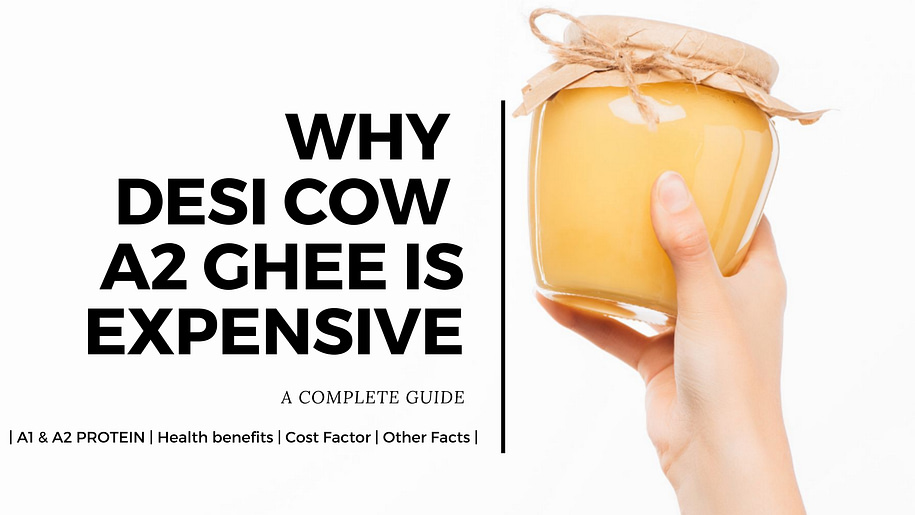Why Desi Cow ghee price and Desi Gir Cow A2 ghee price are so expensive?
We come across varieties of ghee at the retail stores and while shopping online. You would have thought why Desi Cow Ghee Price is usually higher than the other ghee? Right?
A lot of brands recently have started introducing desi cow ghee or gir cow ghee, under the A2 ghee name.
And I though it is important to understand why Pure Desi Gir Cow A2 Ghee Price is usually way higher than the other ghee out there in the market.
Understanding What is A2 Ghee (helps understand Desi Cow Ghee Price difference)
What is A2 ghee?
Why A2 gir cow ghee or A2 desi cow ghee are so expensive?
A2 is beta-casein protein. This is characterized by a golden color. And these proteins contain short-chain amino acids, against the A1 protein which contains long-chain amino acids.
Short-chain amino acids are basically very light on your gut.
A1 protein is responsible for heart diseases and high cholesterol, whereas A2 protein helps you get rid of unnecessary cholesterol and helps your heart stay very healthy.
This is the reason (basic reasons, there is in-depth understanding around the significance of A2 protein) why A2 ghee and milk are what we must actually have, and must avoid A1 milk and ghee at every cost.
Knowing Pure Desi Cow Ghee Price Factor
First, A2 protein is produced by the milk from the desi cows. That is, Indian cows. There are many breeds from the Indian origin and names like Gir cow, Ongole cow, Rathi cow, Tharparkar cow, Kankrej cow, Sahiwal cow, etc you would have come across.
All these cows are native Indian cows and they commonly have a hump on their back, which the European breeds (HF, Jersey, and others) don’t.
Non-Indian cows produce milk containing A1 protein, the reason behind most of the heart and other diseases.
What about the cost now?
Well, European cows produce about 12-18 liters of milk, whereas, then Desi Indian Cows produce about 4-7 liters of milk.
Now that’s a huge difference in the outcome and the cost of managing both the breeds is almost the same.
Straight away we can see that about three times is the yield with the non-Indian cows.
That’s the reason why most dairy companies (big and small) employ non-Indian breeds. And the reason is ‘profit’.
But, we care about what happens to our health. And not about the profits of these companies, right?
So, recently a lot of brands who believe in producing authing and real stuff, have started adopting the authentic Indian cows.
Though they produce very less milk compared to the other breeds, these dairy farmers want to promote the A2 protein-based milk, ghee, and other dairy products so that the health-conscious people can get what they really deserve.
Let’s look at the numbers.
Eg: The cost of managing a cow is 10000 monthly
If the European cow yields 15 liters a time, then, twice milking in the day gives us 30 liters a day and 900 liters a month.
Costing about 11 per liter.
Same way, the Indian desi cow will yield about 5 liters per time, 10 liters a day, and about 300 liters a month. Costing about 33 per liter.
If ghee made out of European milk costs 500 then the cost of ghee made using Indian cows should be 1500? Right?
This is one of the major reasons why the ghee from Gir cow or any other desi cow is really high, compared to the other ghee commercially available.
Apart from this, there is a huge difference in making ghee.
A lot of commercial companies make ghee using the cream taken from the milk.
Whereas the authentic ghee is produced only when milk is converted to curd, then using traditional bilona (bi-directional churning) the white butter is extracted and then after heating ghee is made.
In the first method, the leftover is milk which yields a high price in the market, and in the second method, the leftover is butter-milk which yields low prices and sells only if there is a demand. And buttermilk sells only in the summer season.
Thirdly, the feed of the cow determines the quality of the milk and hence ghee. A lot of dairy owners feed cheap and rubbish food to the cows. The quality of their food results in the quality of the milk they give.
What would you choose to have for your family?
In the dairy business, there are a lot of ways to cut the cost, and the result is only in the quality of the product and our health.
And when we think of products like milk, curd, and ghee, we have them only and only because we think it is healthy and must-have for our family’s health.
And if we have A1 protein-based milk and ghee. Or, rubbish fed cow’s milk or ghee, then, we are not doing any good to our family in real sense.
What should you know about Desi Cow Ghee?
So next time when you want to buy ghee, please try understanding if the brand has an authentic desi Indian cow breed?
And if they feed high-quality food their cattle?
Do they follow the curd-bilona process to make ghee?
If yes to all, then, do not think it is expensive. Think that it is the REAL ghee.
And that’s the ghee your family must be having.
Why I started the cow dairy and ghee making
When my son was newly born in 2012, I was very very curious about what my wife should and what my infant son must-have.
I never allowed even mobile phones to enter the room where my son was.
Then slowly I started learning about the realities of the food industry and their good and bad facts.
This is the real seed that made me build ‘Hous of Life’, with a mission of producing only and only authentic food that we humans actually deserve.
At Hous of Life, we have authentic Gir cows and Kankrej cows. These cows are picked scrutinizing their history (parents and grandparents) thoroughly. To ensure that they are pure breeds.
They are fed what they actually deserve and are made sure to be happy every day.
Their calves drink ample milk and eat ample food.
The milk to ghee process is totally authentic, using natural substances like Kadai and cow dung for fire.
The satisfaction I get after looking at the end product is simply mesmerizing.
I always wished if my kids had the opportunity to have such food right since the conception through their mother. But I knew no such company that followed the real and authentic ways of making.
What all do you want to know?
I love interacting about the authenticity in food, diet and recipes, and kitchen, and if that’s your interest too then please feel to comment here and I’d to jump into the conversation.
Do check Hous Of Life’s pure desi cow A2 ghee, pure Gir cow A2 ghee, and pure Kankrej cow A2 ghee.
So, if next time dow get thought about pure desi cow ghee price or pure Gir cow ghee price and why them being higher, then the only thing you gotta do is to verify if the breed is for real Indian cow, ghee making is using bilona method and food used in the dairy is of high quality.
Believe me, if these three questions are assured then you desi cow or desi gir cow A2 ghee is in no way expensive.
You would have come across a saying in the good old days in India that, ‘even if you have to take a loan to buy ghee, it is going to worth it’.
And in good old days in India, we only had desi Indian breeds, made ghee at home using traditional bilona method and cows were food the same as what we had. Because these cows were like our family members.
Stay healthy!




